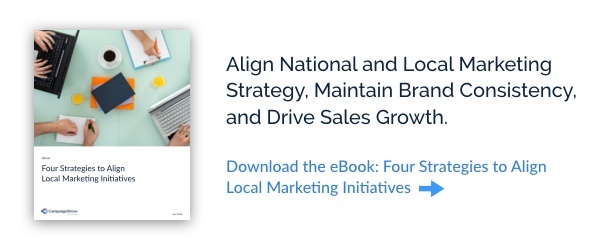Today’s marketing managers are facing pressure to produce more content and marketing assets than ever before. Not only are marketing teams asked to create more original advertising content, these marketing assets often need to be ready for distribution across multiple channels — including both print and digital. “While technology allows this, content has often become the bottleneck,” writes marketing technology expert Tim Kopp of Venture Park Partners, referring to the struggle many marketers face when it comes to organizing and repurposing assets.
Organizations that succeed against the growing pressure to create and publish more content are adopting tools and processes that support effective asset storage, retrieval, and repurposing. In 2017, a marketing “asset” isn’t just the groundwork for advertising, it’s potentially a building block that can be revised, edited, and modified for future campaigns.
At distributed brands, where a brand management team supports a large, geographically-diverse network of franchisees, dealerships, or other local representatives, the challenges around effectively storing, retrieving and versioning marketing assets can be even more daunting. A single print template may be modified and edited hundreds of times in order to be published as an ad, or sent as a direct mail piece. Today’s distributed brand managers need solutions not just for effectively managing their rapidly-growing libraries of assets, but also for supporting all the ways those assets will be used, both nationally and locally.
Why Distributed Brands Need DAM Tools
Digital asset management is a category of software used by brands to manage and store digital versions of marketing assets. Organizations of all types see the following benefits from the right DAM tool:
- Comprehensive storage of digital marketing assets
- A single, global system of record for using those assets in worldwide marketing activities
- 24/7 access to marketing assets with cloud-based or Software-as-a-Service (SaaS) DAM tools
- Improved workflow visibility and more consistent marketing processes
- Higher asset ROI as assets are reused and repurposed
- Improved oversight of marketing activities
Distributed organizations get all of these benefits from DAM, as well as but they can also find solutions to problems that won't be faced by your typical, more centralized company. Brand managers at multi-location brands often face tension around ownership of marketing messages, fears that their brand standards are not being protected in the field and difficulty communicating updates to their local marketers. These struggles are often best solved by tools specifically designed for distributed use cases.
Distributed Digital Asset Management (Distributed DAM) is an emerging category of asset management technology that helps solve these problems. In addition to the ten core characteristics of DAM tools, distributed solutions are generally cloud or SaaS-based, and typically offer the following features:
- Templates: The ability to control how assets can be edited by local marketers to protect brand standards.
- Content Management: The ability to structure all content types, including written content and imagery, in a way that allows it to be used for different mediums and templates.
- Fulfillment Capabilities: Integration of the DAM with print vendors so local marketers can easily order their collateral right from the tool.
- Permissions Structure: Capabilities that allow brand managers to control who can access local marketing content with fine-tuned permissions.
- Reporting: Insights into local marketer activity and marketing performance.
While distributed DAM is a relatively new category of software, there are multiple ways for brand marketing managers to approach how they solve their pain points with this technology. Read on for a list of questions to consider as you define your distributed brand’s technology requirements and begin evaluating vendors.
For more insight on options for localized or distributed DAM and how it can benefit distributed brands, we recommend the following Pica9 articles:
- The 5 Best SaaS DAM Tools for 2017
- Which Distributed DAM Tool is Right for Your Company?
- 3 DAM Tips You Can Steal to Streamline Your Campaign Creation
9 Questions to Ask Before Making the Switch to DAM Software
The right decision about distributed DAM software should align with your organization's big picture strategy for distributed marketing success. There are certain attributes of a DAM tool for multi-location brands that shouldn't be optional. For instance, if you're going to support local marketers all around the country or the globe, a cloud-based or SaaS tool is a necessity. However, developing a better understanding of your own needs can help you find a solution that's prepared to scale with your growth goals and supports local marketers in a way that leads to higher adoption rates.
Distributed brand managers succeed when they start by considering their data reporting needs, user access and permissions, and the quality of the user interface. Highly-customizable and seamlessly fitting into your existing workflows, the right DAM helps brands yield better results and support local marketers more efficiently.
Brand managers should always ask themselves the following nine questions before launching a DAM project to better understand their multi-location organization's true needs for scalability, asset volume, workflows, compliance, and more:
Question #1: How Many New Assets are Produced Annually?
How much time does your design team have time to create new projects and assets? Are they constantly working to help local outlets update assets for one-off use? Understanding the status of your asset flow helps you hone in on the needs of the design team, the needs of the local affiliates, and helps with a greater understanding of where your asset creation process is bottlenecked.
When estimating the number of assets you produce annually, it’s important to understand the number produced by your design team and local versions. If your design team is producing one-off assets daily for hundreds of franchisees, your current workflow is not working. Ideally, your team should be able to create a series of customizable templates, that can easily be localized by the local marketer.
Question #2: What is the Average Lifespan of an Asset?
An asset's lifespan is largely determined by how long it is usable in-market. If a direct mail piece is stale after one use, because of an in-the-moment cultural reference, then it has a very short lifespan. Measuring the average lifespan of an asset helps you understand how long each asset should live in the DAM at each stage of its lifecycle. If many of your brand's assets are only good for one-time use, the ROI on the DAM system that you choose needs to account for the constant cost of creating new assets.
One of the best ways to extend the lifespan of your assets is to repurpose them. Distributed DAM tools have the potential to dramatically expand the average lifecycle of your marketing assets because they allow you to repurpose them. Assets such as product photography, or holiday templates, can be repurposed for many mediums and seasons. By selecting a DAM tool that offers features to support repurposing, such as the ability to associate images with a template, you help increase the value that you get from those assets.
Question #3: What are Our Legal and Regulatory Requirements?
Distributed brands in finance, healthcare, and other highly-regulated industries must abide by strict laws, and the legal team is responsible for enforcing compliance accordingly. If your organization is required to include disclosures with marketing or meet requirements set by a regulatory body (SEC, FINRA, HIPPA), your DAM should let you restrict who can use your assets to ensure they always follow the compliance rules.
Question #4: How Much Visibility into Local Marketing Do I Have?
While some distributed brands understand exactly how their local marketers use assets, many others struggle with a lack of transparency. It's important to understand what information you don't know today about your marketing assets, so that you can prioritize what you hope your DAM system will teach you in the future. Ideally, your new distributed DAM should act as a window into local marketer activity. Your reporting dashboards should reveal adoption levels, and which local marketers are using what assets. This supports your need to connect your assets and campaigns to local marketing results, and improves your future campaigns based on real performance data.
Question #5: Do Local Marketers Need to Upload Assets?
A distributed DAM that’s designed to be so comprehensive that only the brand management team knows how it works will significantly hinder any progress that you want to make with your local marketers. If you need your local marketers to use their own local assets or images in marketing materials, your DAM should be designed for ease-of-use at the local level. The right DAM will have a simplified interface for local marketers so that they can get the work done that they need to — without worrying about the extra configurations that a real marketing professional may need. A great DAM will also allow your brand management team to have that comprehensive view without disrupting the simple experience that is presented to the end user.
Question #6: How often do local marketers need to personalize their own assets?
If your local marketers are constantly bothering your design team with requests to personalize campaigns, chances are they may feel rushed to personalize an asset and do it on their own — even if it's not up to brand standards. By understanding how your local marketers interact with assets, and their needs, you are better able to provide them with the resources they need to be successful. If your locals are often requesting personalized assets, look for a DAM solution that will enable them to collaborate and add assets to the system for approval.
Question #7: Are you using other software or tools to help with multi-location marketing?
The tools and technologies organizations need for marketing have evolved significantly. A one-size-fits-all solution for end-to-end marketing resource management (MRM) is rarely ideal for today’s brands, who are increasingly seeking lighter weight, cloud-based tools.
If you will be integrating your new software with existing tools, your Distributed DAM should offer an open API for integration with tools like your web content management system (CMS), budgeting, project management, and more.
Question #8: How Much Configuration is Required?
No two distributed organizations are the same. Even though distributed DAM is a specialized category of software, your organization needs to customize features to meet the needs for team members, workflows, and processes. Depending on your resources and needs, you may want a platform that will let you configure it just the way you need to on your own, as opposed to one that requires a development team to implement a customized interface for you.
Question #9: Will This DAM System Grow With Us?
How big is your organization? How many local outlets do you support, and how quickly are you growing? If your organization is growing, or has plans to expand significantly in the years to come, it’s important to ensure that your tool can accommodate the needs of an expanding network of users.
Other aspects of scale to consider include languages, asset storage, and pricing:
- Language: If your brand is international or plans to expand to international locations, the DAM tool you choose needs to include support for different languages and character sets.
- Asset Storage: Some DAM solutions offer limited storage space, or require organizations to BYOS (buy their own storage). Distributed brands are extremely likely to see their total asset library expand rapidly due to the size of their network and the fact that each local outlet might create their own localized version of each asset or template in the DAM. Distributed DAMs need to be highly scalable to account for the sheer volume of assets and documents that will be used.
- Pricing: Understanding how your brand’s current scale and plans for growth will impact the price you pay for your DAM is important. Evaluate the costs of adding each additional user, and ensure that you won’t encounter any surprises if you need to expand your storage or user base.
Selecting the Right DAM Tool: Define Your Requirements First
Digital assets are crucial to the success of distributed brand management teams. Your organization’s continued success depends on your team’s ability to create a brand that customers love and support local marketing campaigns at the same time. While digital asset management (DAM) software can help any company create structure and systems of reuse from a high volume of assets, distributed brands gain particular benefits from the templating, permissioning and reporting features.
By defining your organization’s specific requirements, you are better prepared to select a tool that’s transparent, user-friendly and ready-to-scale. By understanding your existing workflows and needs, it’s possible to avoid lengthy, complex and costly software implementations (that might even go nowhere). Making sure you know how your needs align with the tools available to choose from, you can establish a solid groundwork for effective asset management practices.
How do well-known distributed brands like Marriott, Polaris, and the Melting Pot use multi-location marketing software to effectively manage their assets? Learn their success secrets, and more, in our free eBook Distributed Marketing on Steroids: The Brand Manager’s Guide to Designing and Managing Local Marketing Assets Without Breaking a Sweat. 




